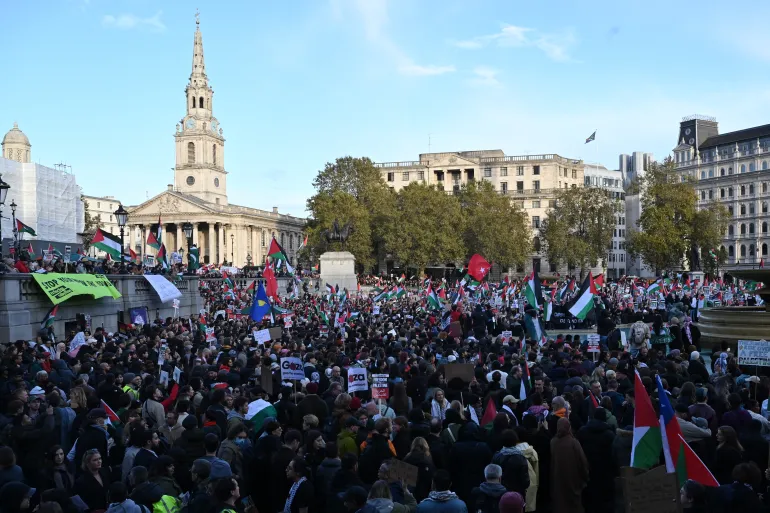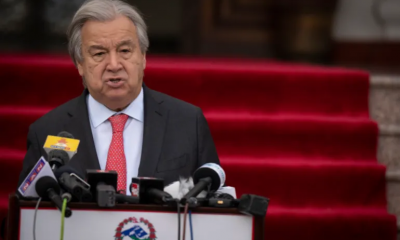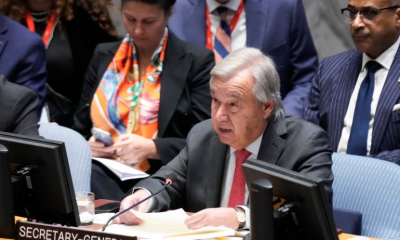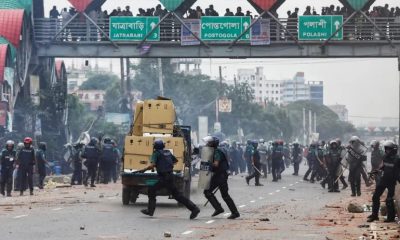Foreign News
Protesters rally around the world demanding immediate ceasefire in Gaza

Tens of thousands of people have taken to the streets in cities across the world for a weekend of demonstrations demanding an immediate ceasefire in Gaza.
Pro-Palestine demonstrations took place on Saturday in various cities including Washington, DC; London; Paris; Berlin; Milan and Dhaka. In Turkey, a convoy of Palestine supporters headed to a US military base in the south of the country for a protest to coincide with US Secretary of State Antony Blinken’s arrival to the country on Sunday.
On Saturday, at least 15 people were killed and dozens more wounded in an Israeli attack on al-Fakhoora school in Jabalia refugee camp as Israel continued its air and ground assault of the besieged enclave.
Since the war began, 9,488 Palestinians have been killed in Gaza. More children have died in Gaza in this war so far than in all conflicts around the world in each of the past four years, according to the charity Save the Children. More than 1,400 people in Israel have died, mostly in the October 7 attacks by Palestinian group Hamas on southern Israel.
United Kingdom
Large crowds held sit-down protests in London blocking Oxford Circus and Piccadilly Circus before marching to and gathering in Trafalgar Square.
Protesters held “Freedom for Palestine” placards and chanted “ceasefire now” and “in our thousands, in our millions, we are all Palestinians”.
London’s Metropolitan Police estimated that around 30,000 attended the rally. Police said they had made 11 arrests, including one for displaying a placard that could incite hate, contrary to terrorism legislation.
Earlier, some demonstrators had also gathered outside the BBC headquarters in London in protest at the network’s coverage of the war, which they called “biased”.
Echoing Washington’s stance, British Prime Minister Rishi Sunak’s government has stopped short of calling for a ceasefire, and instead advocated humanitarian pauses to allow aid into Gaza.
France
Thousands also marched in central Paris to call for a ceasefire with placards reading “Stop the cycle of violence” and “To do nothing, to say nothing is to be complicit.”
It was one of the first, big gatherings in support of Palestinians to be legally allowed in Paris since the war began.
“We came here today to show the people of France’s solidarity with the Palestinian people and our support for peace, for a peace solution with two states, an Israeli state and a Palestinian state,” said Antoine Guerreiro, a 30-year-old civil servant.
Wahid Barek, a 66-year-old retiree, lamented the deaths of both Israeli and Palestinian civilians.
“I deplore civilian deaths on both sides. Civilians have nothing to do with these actions. It really is shameful,” he said.
Germany
In Berlin, about 6,500 people gathered at midday for a demonstration that police said was taking place under strict conditions. Germany had previously banned Palestine solidarity rallies.
People carrying Palestinian flags and placards reading “Stop the genocide in Gaza” or “From the river to the sea – we demand equality” gathered on Alexanderplatz, a major square in the centre of the city.
One speaker called for an end to the “apartheid culture” and a stop to the bombing of Gaza.
![In Berlin, around 6,500 people gathered for a demonstration that police said was taking place under strict conditions. [REUTERS/Liesa Johannssen]](https://www.aljazeera.com/wp-content/uploads/2023/11/Berlin-1699125153.jpeg?w=770&resize=770%2C513&quality=80)
In Berlin, about 6,500 people gathered for a demonstration that police said was taking place under strict conditions (Aljazeera)
Italy
Some 4,000 protesters marched through the streets of Milan in support of a ceasefire, according to local media.
The demonstration called under the slogan “Stop war, no racism” took place just as in a nearby square, the far-right League party held a rally “in defence of the West”.
Senegal
In the Senegalese capital, Dakar, people gathered outside the central mosque with placards and Palestinian flags.
“This protest was supposed to take place last week, but it was banned,” Al Jazeera’s Nicholas Haque reported from Dakar. “There are many Senegalese people, but also the Lebanese Senegalese community has also come out in numbers to show their support.”
Turkey
Hundreds of protesters gathered in Istanbul and Ankara, a day before a visit to Turkey by US Secretary of State Antony Blinken for talks on Gaza. In Istanbul’s Sarachane Park, they held banners that read, “Blinken, the accomplice of the massacre, go away from Turkey”, with a picture of Israeli Prime Minister Benjamin Netanyahu and Blinken together with a red “X” mark on it.
In the Turkish capital, Ankara, demonstrators rallied near the US embassy, chanting slogans and holding posters which read: “Israel bombs hospitals, Biden pays for it.”
Meanwhile, a “freedom convoy for Palestine” headed to the Incirlik military base near the southern city of Adana, primarily used by Turkish and US forces. Organisers expects thousands of vehicles to converge around the base on Sunday.
![Demonstrators rally in support of Palestinians in Washington, DC, on November 4, 2023. [OLIVIER DOULIERY / AFP]](https://www.aljazeera.com/wp-content/uploads/2023/11/33ZR3F7-highres-1699126818.jpeg?w=770&resize=770%2C513&quality=80)
United States
Tens of thousands took to the streets in Washington, DC in the largest demonstration since the war began on October 7.
“I am surrounded by a sea of protesters, more than I have seen since the war on Gaza started,” Al Jazeera’s Heidi Zhou-Castro said. “Organisers have called this the big one, they are expecting somewhere between 20,000 up to 100,000 people,” she added. “The crowd around me isn’t just Arab Americans who are rallying in support of Palestinians in Gaza, but also many Americans from all walks of life.”
A Jewish American protester attending a march for Gaza said President Joe Biden needs to stop funding Israel’s army.
“I’m a human being and I care about the people in Gaza being murdered. I care about genocide going on in the name of Jewish people by Zionists who do not represent Judaism,” he told Al Jazeera.
“I object to the US funding this genocidal war. That’s what we’re doing – it wouldn’t happen if the US did not fund Israel,” he said.
(Aljazeera)
Foreign News
Nasa ‘Earthrise’ astronaut dies at 90 in plane crash

Apollo 8 astronaut Bill Anders, who snapped one of the most famous photographs taken in outer space, has died at the age of 90.
Officials say a small plane he was flying crashed into the water north of Seattle, Washington.
Anders’ son Greg confirmed that his father was flying the small plane, and that his body was recovered on Friday afternoon. “The family is devastated. He was a great pilot. He will be missed,” a statement from the family reads.
Anders – who was a lunar module pilot on the Apollo 8 mission – took the iconic Earthrise photograph, one of the most memorable and inspirational images of Earth from space.
Taken on Christmas Eve during the 1968 mission, the first crewed space flight to leave Earth and reach the Moon, the picture shows the planet rising above the horizon from the barren lunar surface.
Anders later described it as his most significant contribution to the space programme.

The image is widely credited with motivating the global environmental movement and leading to the creation of Earth Day, an annual event to promote activism and awareness of caring for the planet.
Speaking of the moment, Anders said: “We came all this way to explore the Moon, and the most important thing that we discovered was the Earth.”
Officials said on Friday that Anders crashed his plane around 11:40PDT (1940BST).
The US National Transportation Safety Board (NTSB) said the 90-year-old was flying a Beechcraft A A 45 – also known as a T-34. The agency said that the plane crashed about 80ft (25m) from the coast of Jones Island.
Anders also served as the backup pilot to the Apollo 11 mission, the name of the effort that led to the first Moon landing on July 24, 1969.
Following Anders’ retirement from the space programme in 1969, the former astronaut largely worked in the aerospace industry for several decades. He also served as US Ambassador to Norway for a year in the 1970s.
But he is best remembered for the Apollo 8 mission and the iconic photograph he took from space.
“In 1968, during Apollo 8, Bill Anders offered to humanity among the deepest of gifts an astronaut can give. He traveled to the threshold of the Moon and helped all of us see something else: ourselves,” Nasa Administrator Bill Nelson said in a statement.
Mark Kelly, a former astronaut who now serves as a US Senator for the state of Arizona, said in a post on X, formerly Twitter, that Anders “inspired me and generations of astronauts and explorers. My thoughts are with his family and friends”.
[BBC]
Foreign News
China’s Chang’e-6 lifts off from far side of Moon with rock samples

A Chinese spacecraft carrying rock and soil samples from the far side of the Moon has lifted off from the lunar surface to start its journey back to Earth, according to state media.
The achievement on Tuesday is a world first and the latest leap for Beijing’s decades-old space programme, which aims to send a crewed mission to the Moon by 2030.
The Xinhua News Agency, citing the China National Space Administration (CNSA), said that the ascender of the Chang’e-6 probe took off at 7:38am local time on Tuesday (23:38 GMT) and entered a preset orbit around the moon.
It described the move as “an unprecedented feat in human lunar exploration history”.
The Chang’e-6 probe was launched last month and its lander touched down on the far side of the Moon on Sunday. It used a drill and robotic arm to dig up soil on and below the Moon’s surface, according to Xinhua.
After successfully gathering its samples, the Chang’e-6 unfurled China’s national flag for the first time on the far side of the Moon, it said.
The agency cited the CNSA as saying that the spacecraft stowed the samples it had gathered in a container inside the ascender of the probe as planned.
[Aljazeera]
Foreign News
China says its spacecraft lands on Moon’s far side

China says its uncrewed craft has successfully landed on the far side of the Moon – an unexplored place almost no-one tries to go.
The Chang’e 6 touched down in the South Pole-Aitken Basin at 06:23 Beijing time on Sunday morning (22:23 GMT Saturday), the China National Space Administration (CNSA) said.
Launched on 3 May, the mission aims to collect precious rock and soil from this region for the first time in history. The probe could extract some of the Moon’s oldest rocks from a huge crater on its South Pole.
The landing was fraught with risks, because it is very difficult to communicate with spacecraft once they reach the far side of the Moon. China is the only country to have achieved the feat before, landing its Chang’e-4 in 2019.
After launching from Wenchang Space Launch Center, the Chang’e 6 spacecraft had been orbiting the Moon waiting to land. The lander component of the mission then separated from the orbiter to touch down on the side of the Moon that faces permanently away from Earth.
During the descent, an autonomous visual obstacle avoidance system was used to automatically detect obstacles, with a visible light camera selecting a comparatively safe landing area based on the brightness and darkness of the lunar surface, the CNSA was quoted as saying by state-run Xinhua news agency.
The lander hovered about 100m (328ft) above the safe landing area, and used a laser 3D scanner before a slow vertical descent. The operation was supported by the Queqiao-2 relay satellite, the CNSA said.
Chinese state media described the successful landing as an “historic moment”. The state broadcaster said “applause erupted at the Beijing Aerospace Flight Control Center” when the Chang’e landing craft touched down on the Moon early on Sunday morning.
The lander should spend up to three days gathering materials from the surface in an operation the CNSA said would involve “many engineering innovations, high risks and great difficulty”. “Everyone is very excited that we might get a look at these rocks no-one has ever seen before,” explains Professor John Pernet-Fisher, who specialises in lunar geology at the University of Manchester.
He has analysed other lunar rock brought back on the American Apollo mission and previous Chinese missions. But he says the chance to analyse rock from a completely different area of the Moon could answer fundamental questions about how planets form.
Most of the rocks collected so far are volcanic, similar to what we might find in Iceland or Hawaii. But the material on the far side would have a different chemistry . “It would help us answer those really big questions, like how are planets formed, why do crusts form, what is the origin of water in the solar system?” the professor says.
The mission aims to collect about 2kg (4.4lb) of material using a drill and mechanical arm, according to the CNSA.
The South Pole–Aitken basin, an impact crater, is one of the largest known in the solar system.
From there, the probe could gather material that came from deep inside the lunar mantle – the inner core of the Moon – Prof Pernet-Fisher says.
The Moon’s South Pole is the next frontier in lunar missions – countries are keen to understand the region because there is a good chance it has ice.

The capsule in the last Chinese moon mission, Chang’e 5, brought back soil and rocks in 2020 (BBC)
Access to water would significantly boost the chances of successfully establishing a human base on the Moon for scientific research.
If the mission succeeds, the craft will return to Earth with the precious samples on board a special return capsule.
The material will be kept in special conditions to try to keep it as pristine as possible.
Scientists in China will be given the first chance to analyse the rocks, and later researchers around the world will be able to apply for the opportunity too.
This is the second time China has launched a mission to collect samples from the Moon.
In 2020 Chang’e 5 brought back 1.7kg of material from an area called Oceanus Procellarum on the Moon’s near side.
China is planning three more uncrewed missions this decade as it looks for water on the Moon and investigates setting up a permanent base there.
Beijing’s broader strategy aims to see a Chinese astronaut walk on the moon by around 2030.
The US also aims to put astronauts back on the moon, with Nasa aiming to launch its Artemis 3 mission in 2026.
(BBC)
























